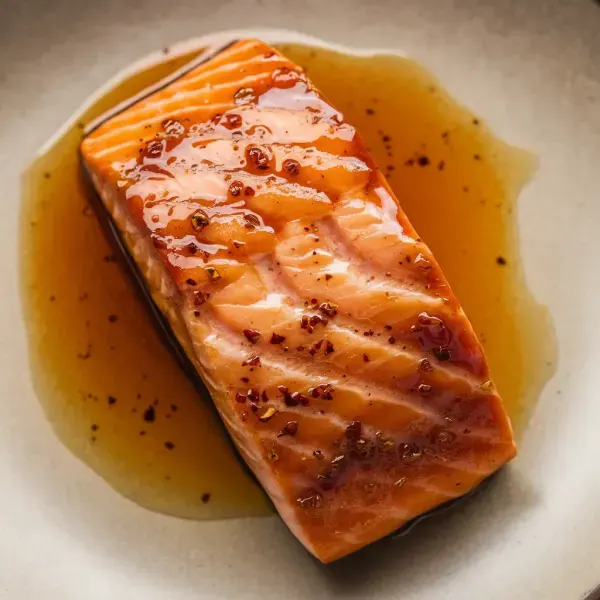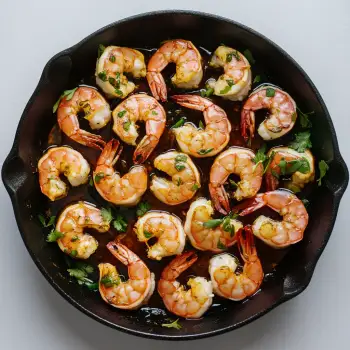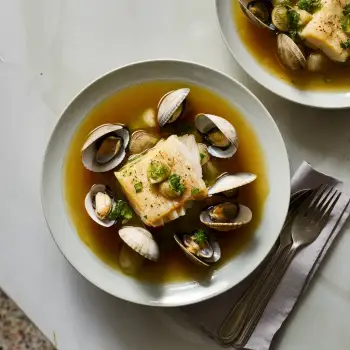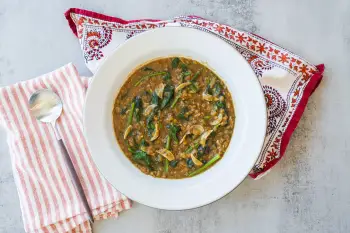
 17 minutes
17 minutesA delightful salmon dish with a perfect balance of sweet and spicy flavors, featuring a Dijon mustard and brown sugar glaze.


Salmon fillets, preferably wild or farmed organically
0 oz
tablespoons
tablespoons
to taste
to taste
1. Preheat Oven
Preheat your oven to 400 degrees. This will ensure it’s ready to go when you need to roast the salmon, guaranteeing even cooking.
2. Create Glaze
Create a delightful glaze by mixing 3 tablespoons of Dijon mustard with 3 tablespoons of brown sugar. Adjust the amounts to achieve your preferred balance of spicy and sweet.
3. Season Salmon
Season your salmon fillets generously with salt and black pepper. This simple step enhances the natural flavors of the fish, ensuring every bite is delicious.
4. Prepare Baking Sheet
Prepare a baking sheet by lining it with foil and lightly oiling it. This prevents the salmon from sticking and makes clean-up a breeze. Place the salmon fillets on the sheet, skin-side down.
5. Apply Glaze
Spread the mustard and brown sugar mixture evenly over the tops of the salmon fillets. This glaze will melt and caramelize during roasting.
6. Roast Salmon
Roast the salmon in the top half of your oven for about 12 minutes. You’ll know it’s done when the salmon is opaque and flakes easily with a fork.
7. Serve
Serve the salmon hot, perhaps with a side of steamed vegetables or a fresh salad. Enjoy the harmony of sweet and spicy flavors in every bite!
Incorporate soy sauce, hoisin, or oyster sauce into the glaze, using ginger and garlic as aromatics. This will give you a teriyaki-like glaze.
Replace salmon with chicken breasts or thighs. Adjust cooking time until chicken is cooked through (internal temperature of 165°F). The glaze works beautifully on the chicken, creating a caramelized exterior.
A pork tenderloin or chops can be substituted for salmon. Pork pairs well with sweet and spicy flavors, and the glaze will help keep the meat moist while adding a burst of flavor.
Mix together soy sauce, grated fresh ginger, a little honey, and sesame oil. Add a sprinkle of Gochugaru (Korean red pepper flakes) for a mild but distinct spiciness. This will give an Asian flair to your dish.
Utilize tropical fruits like pineapple or mango puree for sweetness, and habanero or Scotch bonnet peppers for heat. Lime juice and cilantro can be the acid and aromatic components.
Look for fresh, wild-caught salmon if possible. Wild-caught varieties like King (Chinook) or Sockeye have a richer flavor and firmer texture. If available, a center-cut piece ensures even cooking and presentation. Ensure the salmon is of good quality, with bright color, firm flesh, and a clean smell.
Aim for an internal temperature of 120-125°F (medium-rare to medium) for the best texture and moisture retention. Use a meat thermometer to avoid overcooking, as salmon can dry out quickly.
The glaze should have a balance of sweet, spicy, and acidic elements. Use high-quality honey or maple syrup for sweetness, and for heat, consider a blend of chili flakes and a touch of a milder pepper like ancho or smoked paprika for depth. Freshly squeezed lime or lemon juice provides the necessary acidity to cut through the sweetness and the richness of the salmon.
After removing the salmon from the heat, let it rest for a few minutes. The residual heat will finish cooking the fish gently, and the resting time allows the juices to redistribute.
Before seasoning or cooking the salmon, pat it dry with paper towels to remove excess moisture. This helps achieve a better sear. Also, let the salmon sit at room temperature for about 15 minutes before cooking, which promotes even cooking.




Comments (0)